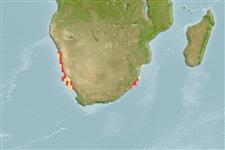Teleostei (teleosts) >
Eupercaria/misc (Various families in series Eupercaria) >
Sparidae (Porgies)
Etymology: Lithognathus: Greek, lithos = stone + Greek, gnathos = jaw (Ref. 45335).
More on author: Cuvier.
Environment: milieu / climate zone / depth range / distribution range
Ecology
Marine; brackish; benthopelagic; amphidromous (Ref. 51243); depth range ? - 150 m (Ref. 27121). Subtropical; 22°S - 31°S
Southeast Atlantic: known only from the Orange River mouth to Natal, South Africa.
Length at first maturity / Size / Weight / Age
Maturity: Lm 54.0 range ? - ? cm
Max length : 200 cm TL male/unsexed; (Ref. 3198); common length : 65.0 cm TL male/unsexed; (Ref. 3507)
Found over sandy substrate, in estuaries and oceanic waters. Enters lagoons (Ref. 3198). Feeds bottom invertebrates, including worms, crabs and shrimp (Ref. 27121). Spawns in the sea but uses estuaries as nursery grounds. Prime angling fish. Important food fish. Sold fresh and whole in markets.
Life cycle and mating behavior
Maturity | Reproduction | Spawning | Eggs | Fecundity | Larvae
Bauchot, M.-L. and M.M. Smith, 1984. Sparidae. In W. Fischer and G. Bianchi (eds.) FAO species identification sheets for fishery purposes. Western Indian Ocean (Fishing Area 51). volume 4. [var. pag.] FAO, Rome. (Ref. 3507)
IUCN Red List Status (Ref. 130435)
Threat to humans
Harmless
Human uses
Fisheries: minor commercial; gamefish: yes
More information
ReferencesAquacultureAquaculture profileStrainsGeneticsElectrophoresesHeritabilityDiseasesProcessingNutrientsMass conversion
Tools
Special reports
Download XML
Internet sources
Estimates based on models
Preferred temperature (Ref.
123201): 12.5 - 24.1, mean 15.7 °C (based on 28 cells).
Phylogenetic diversity index (Ref.
82804): PD
50 = 0.5625 [Uniqueness, from 0.5 = low to 2.0 = high].
Bayesian length-weight: a=0.01549 (0.00939 - 0.02556), b=3.04 (2.90 - 3.18), in cm total length, based on LWR estimates for this species & (Sub)family-body (Ref.
93245).
Trophic level (Ref.
69278): 3.1 ±0.1 se; based on diet studies.
Generation time: 10.9 ( na - na) years. Estimated as median ln(3)/K based on 1
growth studies.
Resilience (Ref.
120179): Low, minimum population doubling time 4.5 - 14 years (K=0.1).
Fishing Vulnerability (Ref.
59153): High to very high vulnerability (72 of 100).
Climate Vulnerability (Ref.
125649): Very high vulnerability (78 of 100).
Nutrients (Ref.
124155): Calcium = 24.8 [12.9, 45.8] mg/100g; Iron = 0.664 [0.364, 1.136] mg/100g; Protein = 18.5 [16.9, 20.3] %; Omega3 = 0.302 [0.191, 0.497] g/100g; Selenium = 45.7 [21.7, 85.5] μg/100g; VitaminA = 6.95 [2.03, 19.38] μg/100g; Zinc = 0.722 [0.505, 1.031] mg/100g (wet weight);
